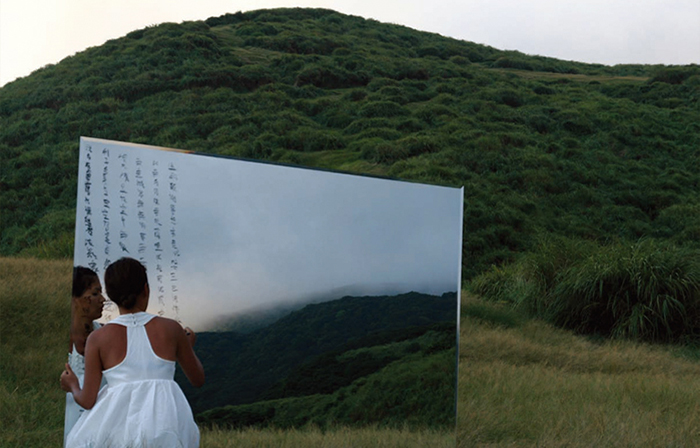Tony Godfrey writing for Leap Magazine
FOR HER MOST recent work Charwei Tsai has amassed a large pile of white feathers. The pile is placed on a circular mirror and heaped up to about half a meter high and one meter across. Down is mixed with wing feathers to make the whole pile seem fluffy and insubstantial. Were this not inside an art gallery, the wind would blow it away. As the viewer gets closer, she begins to notice that inscribed on the spines of some of the feathers is writing. The writing is miniscule: only those with good eyesight or who carry a magnifying glass with them can read it. So, one realizes, it is not just a pile of feathers but also a pile of language. That term “pile of language” recalls a famous drawing, A Heap of Language, made by American land and conceptual artist Robert Smithson in 1966, in which he wrote on a sheet of graph paper 20 lines of text beginning at the bottom with “hieroglyphic neologic word coiner angst…” each line getting shorter so as to form a heap or pyramid with the single word at the apex “language.” In contrast to Smithson’s rather academic-looking exercise, Tsai’s work is highly sensual, and when we finally, if our eyesight is good enough, decipher her miniscule script, we find something very different from the American’s listing of words about language: “During the night I am embracing your image. At dawn the fragrance… If love did not exist… The lute of my heart plays only one song.” These are phrases and sentences by the Sufi poet Rumi. Half-hidden as they are amongst the feathers, we can rarely read complete sentences. But we start to sense this mixture of heady eroticism and yearning: an eroticism and yearning that could be as much a love for God as for another person.
The feathers and down are rejects from a pillow shop—they were too large to be used as stuffing—and she has chosen white feathers because of white’s associations of purity. If Smithson’s work smells of the classroom, Tsai’s smells of either the dovecote or the bedroom. (Of course, associations are always slippery—at one time in Europe or America a white feather was a symbol of cowardice given out to young men who had not volunteered to fight in the First World War; at another time it became symbolic of peace. And of course, white is symbolic of death in China, unlike in the West where black is the funereal color.
The differences between the two works—from mid-century U.S. to contemporary Asia, from a male to a female artist, from the reductively conceptual to the sensuous but conceptually informed—are indicative of how art has changed in 45 years. One aspires to objectivity, the other to a richness of associations. Of course, we all know in Chinese culture writing is very different from what it is in the West. No one looking at Smithson’s work admires his calligraphy. It is functional, no more, much as a student’s lecture notes might be. Even if Tsai’s calligraphy is relatively unpretentious, it is still inevitably more personal and closer to drawing than if written in English. If both works aspire to the general statement, and arguably in her case to self-abnegation, hers is nonetheless more autographic. The actual act of writing in her piece is emphasized by the difficulty of writing on the quills. At the opening of the exhibition in which the work was first shown (held at Tina Keng Gallery in Taipei), she had not even completed the laborious task of writing all the aphorisms of Rumi she intended to. This did not bother her: to return to the gallery and continue the task periodically emphasized theperformative nature of the work. Much as with prayer or chanting, the repetition of the act is important.
Who is Charwei Tsai?
She is an artist for whom the act of writing is key, but whose work has extended to sculpture, film and performance. Born and brought up in Taiwan and then educated in the U.S., her entry point to the art world was working as an assistant to Cai Guo-Qiang. It was he who recommended her for an exhibition at the Cartier Foundation in Paris in 2005. In that and other early exhibitions in Greece and Singapore, she became known for writing on tofu, meat, fish, frogs, lotus leaves, bulbs, and flowers. None of these materials or objects or beings was permanent: the tofu disintegrated during the exhibition, the meat rotted, the lotus flowers became desiccated, frogs, fish and octopi moved away, eventually swam, and hence washed off the ink. Even if they did not move they, too, would eventually inevitably die and rot like the tofu and the meat. Such impermanence mirrored the text she wrote out in these early works, for example the Buddhist Heart Sutra: “…form does not differ from emptiness: emptiness does not differ from form. Form itself is emptiness: emptiness itself is form.”
Later she came to regret writing on animals and sea creatures and determined not to do so again. Inevitably, given the texts she uses, ethical considerations became foremost in her work. Her shift to writing on a mirror and filming that action was partly a response to her unease at causing animals pain, but more importantly, it was a way to make visible the performative act of writing the sutra, an act that was simultaneously personal and ceremonial…
See Full Article HERE.
